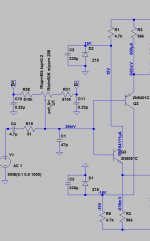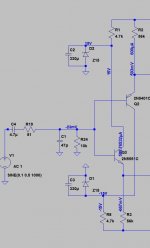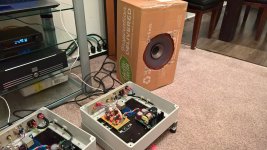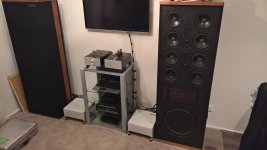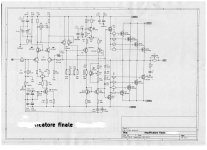Lovely speakers you got there..Completed my clones a while ago.
Using connexelectronic smps without any problems. Used high tolerance, low temp coefficient resistors throughout and gain matched relevant transistors.
Offset stable around 10mV (25mV after 1 hr) on both units. big heatsinks needed.
For those who dislike servos or caps in the nfb decoupling, there is a less painful option to constantly adjusting the offset. It reduces the input impedance which may be an issue with anemic valve preamps. 10k works for me and without a lot of transistor matching i get a rock solid 30mV offset. Significantly better is possible with proper matching.
Attachments
the circuit is undoubtedly critical and its criticality may impose important compromises.
It is difficult to understand today to use a circuit with offset problems if not using condensers and extreme adjustments
in the end you hear the capacitors equalizing by brand and model
It is difficult to understand today to use a circuit with offset problems if not using condensers and extreme adjustments
in the end you hear the capacitors equalizing by brand and model
For those who dislike servos or caps in the nfb decoupling, there is a less painful option [...]
Well, we have to pick our poison, don't we. Servos, coupling caps, NFB caps, low input impedance... Today I finally tried some Mundorf Supremes as coupling caps. Before that I was with DC connection to a 50K DACT and the output offset was terribly floating. Soundwise - not bad at all after allowing for some burn-in time for the Supremes.
To me a 10k input impedance and moderately priced coupling caps start to seem like a viable option.
the conventional, ie floating, filter cell is based on the quality of the capacitors: the electrolytic quality capacitors find them expensive, occupy space and must be wired WELL.
We have modified the 108 modified even in the final stages of power and, if you want to believe me, it is a good step forward compared to floating filtering; in addition, it costs much less, is much better and takes up less space, but it has a cost and requires a certain degree of design.
SE switching provides stabilized voltages is a must, always if it does not radiate or impose other problems; but in this regard it is possible, if it radiates, to resort to the Faraday cage (which I would do anyway).
The fear of audiophiles for switching power supplies is like the fear of children for the dark: they are VOLTAGES
Dear Domenico,
even in adults the fear of darkness is justified: ...the darkness is insidious, dangerous and loss of all sensory perception!!


And audiophiles are right to look with distrust at switching power supplies, always generate voltage but equal they are not.


How are things in Lodi?
Last edited:
always generate voltage but equal they are not.
Not to mention their proclivity to spectacularly blow up once in a while.
And more importantly: how do they sound?
Some people seem ok with smps, even with the original crappy caps. Others insist on upgrading at least the caps. And of course the more hard core members of the hobby will never seriously consider an smps in a high end design
I have no problem using properly designed SMPS units in audio equipment. Good layout, shielding and grounding required.
Compared to my Nord NC-500, bass is less controlled but it sounds really good, no complaints.
Lovely speakers you got there..
They're my test speakers, didn't want to connect to my good ones at that time of testing.
They sound awful, need a tweeter.
Attachments
Dear Domenico,
even in adults the fear of darkness is justified: ...the darkness is insidious, dangerous and loss of all sensory perception!!
And audiophiles are right to look with distrust at switching power supplies, always generate voltage but equal they are not.
How are things in Lodi?
you know what I think about power supplies:
I always want them stabilized everywhere also because the quality of the filtering capacitors affects too much the final result;
plus I can't stand snapins for reasons you know well.
For switching I don't know them, but I will try what I recommend: if it does not radiate we are doing well and I will let you know my opinion, even if it is irrelevant
.
For Lodi it is said to be bad, luckily I have a house in Val Trebbia where I moved for a few months for work convenience.
I add, there is too much psychosis created by the media: in the States they have solved the communication by bringing the costs of the buffer to figures that few can afford, therefore, no crown
Not to mention their proclivity to spectacularly blow up once in a while.
if they explode it means they are poorly constructed and designed.
A test should be made in comparison, with switching THAT DOES NOT IRRADY and conventional
I have no problem using properly designed SMPS units in audio equipment. Good layout, shielding and grounding required.
Compared to my Nord NC-500, bass is less controlled but it sounds really good, no complaints.
true, but if it does not radiate and manage the supply well why not consider them?
if they explode it means they are poorly constructed and designed.
Just look at the number of amps being sold cause the smps packed up. Lots of Chords in fancy cases there
Yes, cheap and light, but do i need another noise source to worry about? Rather leave them to the class D fans where the additional noise just blends in
Just look at the number of amps being sold cause the smps packed up. Lots of Chords in fancy cases thereThe number of blown transformers in linear supplies appears minuscule in comparison.
Yes, cheap and light, but do i need another noise source to worry about? Rather leave them to the class D fans where the additional noise just blends in
Halcro dm88 Reference monoblock power amplifier Measurements | Stereophile.com
Just look at the number of amps being sold cause the smps packed up. Lots of Chords in fancy cases thereThe number of blown transformers in linear supplies appears minuscule in comparison.
Yes, cheap and light, but do i need another noise source to worry about? Rather leave them to the class D fans where the additional noise just blends in
If you wanted to quantify the validity of a switching with the number of power supplies sold with switching power supplies, I would define it as not very indicative. Rather, let's say that the manufacturers sell what the users want, that is GROSSO, see the power supply of the Dartzeel 108 which has no relation to the circuit type.
If a switching does not radiate, and it can be done that it does NOT radiate, why on earth should it provide worse VCC voltages?
it is clear that if a switching irradiates, it only means that it is wrong.
audiophiles claim that stabilizing the final voltages, I mean the final power section, sent, is harmful to the sound:
but who says that based on which literature?
you've tried? And with what?
I have tried and say <never stabilized again! >
there is a basic technical explanation, impedances and noise
same final amp scheme, floating power supply, signal to noise ratio, 116 db,
if I stabilize, I have 123 db and an impedance under load of 3 milliohm, almost an accumulator, against the 2 volts of the float
Last edited:
@domenico
I had bad experience with switching power supply because they add audible noise and also distort. I have tried a HiFiBerry DAC+ PRO which was useless before I have replaced the original power supply with LM317 based linear power supply. I have also almost thrown away brand new mini DSP 2X4 HD because of constant background noise. After replacement of switching power supply with linear, it performed much better.
You are however right about ridiculously oversized rezervoar capacitors. For testing purposes I have made myself smaller power supply consisting of 6X10.000 50V. I have thought: if it even burns, damage would be lower. Surprisingly, it is comparable or the same as 4X48.000 100V device. Without an input signal drivers are dead silent. Obviously, manufacturers of "high-end" devices have their own fake-news channels to justify excessive prices.
Thanks for your valuable contribution to this discussion.
I had bad experience with switching power supply because they add audible noise and also distort. I have tried a HiFiBerry DAC+ PRO which was useless before I have replaced the original power supply with LM317 based linear power supply. I have also almost thrown away brand new mini DSP 2X4 HD because of constant background noise. After replacement of switching power supply with linear, it performed much better.
You are however right about ridiculously oversized rezervoar capacitors. For testing purposes I have made myself smaller power supply consisting of 6X10.000 50V. I have thought: if it even burns, damage would be lower. Surprisingly, it is comparable or the same as 4X48.000 100V device. Without an input signal drivers are dead silent. Obviously, manufacturers of "high-end" devices have their own fake-news channels to justify excessive prices.
Thanks for your valuable contribution to this discussion.
Forums serve this purpose, compare and evaluate.
I add:
- filtering with SNAPIN, which are the worst, but nice to see on the printout
- I turn on and ......... okay
- I replace snapins with serious cans and, much better
- then I try, CASUALLY, to weld 2 mm electric wire on the tracks of the snap-in which are printed: well, the bass changes for the better objectively, and always for a precise technical reason.
So, yes it depends on which capacitors I choose, but also where I place them: if I place them very close, the final power transistors still changes for the better, see Spectral example, 260.
And always for technical reasons.
This is to say that it is not enough to clone a scheme, there are other small problems that in the end, added together, weigh.
yet.
it is a NON sense to have the transformers in the same container as the power amp: put them in a separate box in a Faraday cage, straighten and then connect to the power box:
we have earned 6 db of noise, and we are nobody
I add:
- filtering with SNAPIN, which are the worst, but nice to see on the printout
- I turn on and ......... okay
- I replace snapins with serious cans and, much better
- then I try, CASUALLY, to weld 2 mm electric wire on the tracks of the snap-in which are printed: well, the bass changes for the better objectively, and always for a precise technical reason.
So, yes it depends on which capacitors I choose, but also where I place them: if I place them very close, the final power transistors still changes for the better, see Spectral example, 260.
And always for technical reasons.
This is to say that it is not enough to clone a scheme, there are other small problems that in the end, added together, weigh.
yet.
it is a NON sense to have the transformers in the same container as the power amp: put them in a separate box in a Faraday cage, straighten and then connect to the power box:
we have earned 6 db of noise, and we are nobody
Last edited:
audiophiles claim that stabilizing the final voltages, I mean the final power section, sent, is harmful to the sound:
Regulated supplies sound different. Depending on personal preference this may be interpreted as better or worse. A good example is the Naim NAP250 which has some outstanding qualities but overall is an amp i cannot live with and i feel regulation is to blame.
The regulated/unregulated argument is not limited to just power amps. In preamps a similar set of sonic compromises has to be negotiated when choosing a PS. Not at all sure if regulators always contribute to musicality, yet 99% of high end preamps use some form of regulation.
okay
The Naim 250 is a basic trivial power amplifier with limited performance, cheap sound and not faithful, slow, limited by high low filters and full of compensations that leave ONLY think it is difficult to keep together.
With the NAP it will also improve, it doesn't take much, but the basis remains.
If instead we want to talk about something different place a basic scheme .........
The Naim 250 is a basic trivial power amplifier with limited performance, cheap sound and not faithful, slow, limited by high low filters and full of compensations that leave ONLY think it is difficult to keep together.
With the NAP it will also improve, it doesn't take much, but the basis remains.
If instead we want to talk about something different place a basic scheme .........
Attachments
Last edited:
this is an extreme scheme, tout DC, no servo circuit, no high pass capacitors, no compensations, IN a dualfet, Emitter etc etc.
The scheme is old and is now even more extreme, if anyone wants to go deeper and it is the usual Hitachi book revised and corrected, such as Spectral Goldmund and Norma.
With floating power supply it has 116 db noise.
If I do a stabilizer EVEN of the power amplifiers I arrive at 123 db.
If I put the external transformers in a faraday cage I will reach 129 db.
If I try to listen to what I first heard, I speak of volume, a silly example, but to understand each other, before I went to 12 o'clock, if I stabilize everything I can go quietly at 14 o'clock without any sign of annoyance or compression or distortion.
The bass appears less present, but it is only a sensation: it is very deep, but very controlled.
The scene seems to go beyond the side walls of the room and the dynamic of low and medium low is better.
The grain is very fine
the pattern, I repeat, has still been revised and extreme, if anyone is interested and interested in my impressions of the various changes, I can post them, like the dualfet emitter
The scheme is old and is now even more extreme, if anyone wants to go deeper and it is the usual Hitachi book revised and corrected, such as Spectral Goldmund and Norma.
With floating power supply it has 116 db noise.
If I do a stabilizer EVEN of the power amplifiers I arrive at 123 db.
If I put the external transformers in a faraday cage I will reach 129 db.
If I try to listen to what I first heard, I speak of volume, a silly example, but to understand each other, before I went to 12 o'clock, if I stabilize everything I can go quietly at 14 o'clock without any sign of annoyance or compression or distortion.
The bass appears less present, but it is only a sensation: it is very deep, but very controlled.
The scene seems to go beyond the side walls of the room and the dynamic of low and medium low is better.
The grain is very fine
the pattern, I repeat, has still been revised and extreme, if anyone is interested and interested in my impressions of the various changes, I can post them, like the dualfet emitter
Last edited:
- Home
- Amplifiers
- Solid State
- Dartzeel amp schematic - build this?
